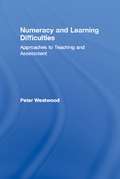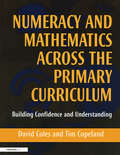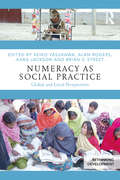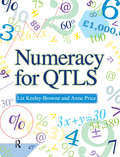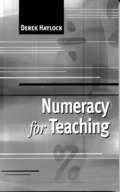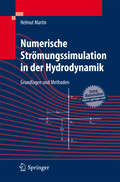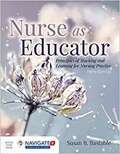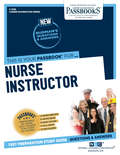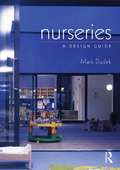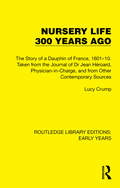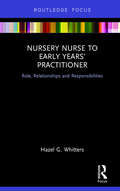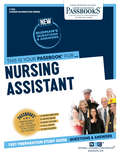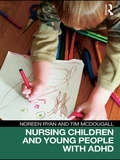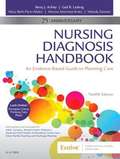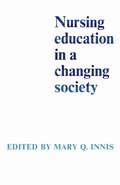- Table View
- List View
Numbers as Cognitive Tools: An Empirically Informed Nominalistic Account of the Nature of Numbers (Synthese Library #510)
by César Frederico dos SantosThis books offers a novel account of the nature of numbers firmly grounded in results from numerical cognition and the philosophy of mathematics. Drawing on empirical data on the human experience of what we call “numbers,” the author shows that numbers do not exist as abstract objects, but that the idea that they do is a useful cognitive tool. Contrary to the platonist view, according to which arithmetic is true of a realm of abstract entities, the nominalistic account presented in this book shows arithmetic to be true of descriptions of structural properties of techniques such as counting and calculating procedures. This book is of interest to both philosophers and cognitive scientists who want to have a deeper understanding of what numbers are.
Numeracy Across the Curriculum: Research-based strategies for enhancing teaching and learning
by Shelley Dole Merrilyn Goos Anne Bennison Helen Forgasz Vince GeigerBeing numerate involves more than mastering basic mathematics. Numeracy connects the mathematics learned at school with out-of-school situations that require capabilities such as problem solving, critical judgment, and sense-making related to non-mathematical contexts. This book provides prospective and practising teachers with practical, research-based strategies for embedding numeracy across the primary and secondary school curriculum. Based on the authors' ten-year research program, the text explains what numeracy is and how numeracy has developed as an educational goal. It describes in detail the five dimensions of the authors' model: attention to real-life contexts; application of mathematical knowledge; use of physical, representational and digital tools; the promotion of positive dispositions towards the use of mathematics to solve problems encountered in day-to-day life; and a critical orientation to interpreting mathematical results and making evidence-based judgements. There is guidance on how to embed numeracy across all subjects within the curriculum, how to assess numeracy learning and how to deal with challenges and dilemmas including working with discipline boundaries and developing support resources.Featuring practical examples and case studies throughout, this book will build pre-service teacher confidence, demystify common misconceptions and grounds theory into practice in this vital area of student competency.'The authors of this text are recognised authorities on numeracy. They have engaged heavily in numeracy research over many years and this text reflects the depth of their understanding and knowledge.' - Geoff Hilton, University of Queensland
Numeracy and Learning Difficulties: Approaches to Teaching and Assessment (Learning Difficulties Ser.)
by Peter WestwoodBy understanding why children struggle with maths, teachers are better equipped to provide effective support and nurture confidence in low-achievers. Numeracy and Learning Difficulties includes how to tackle common learning difficulties by following different teaching practices and principles, identifying gaps in students' knowledge and developing curricula that bridges these gaps, improves numerical literacy using problem-solving strategies and skills, and a handy checklist of benchmarks in achievement.
Numeracy and Mathematics Across the Primary Curriculum: Building Confidence and Understanding
by David Coles Tim CopelandThe key to good primary teaching of numeracy and mathematics is confidence in mathematical knowledge and its relevance to the real world. In particular, effective implementation of the National Numeracy Strategy requires student teachers, primary teachers and mathematics coordinators to realize the place of mathematics across the range of National Curriculum subjects. This book explores mathematics as a set of tools for thinking about, designing, evaluating and changing the world of the child through the broader curriculum, rather than focusing on skills and concept building exclusively in the 'mathematical world.' Practical activities are included to stimulate readers to apply these ideas with confidence both within and beyond the mathematics lesson.
Numeracy as Social Practice: Global and Local Perspectives (Rethinking Development)
by Keiko Yasukawa, Alan Rogers, Kara Jackson and Brian V. StreetLearning takes place both inside and outside of the classroom, embedded in local practices, traditions and interactions. But whereas the importance of social practice is increasingly recognised in literacy education, Numeracy as Social Practice: Global and Local Perspectives is the first book to fully explore these principles in the context of numeracy. The book brings together a wide range of accounts and studies from around the world to build a picture of the challenges and benefits of seeing numeracy as social practice ̶ that is, as mathematical activities embedded in the social, cultural, historical and political contexts in which these activities take place. Drawing on workplace, community and classroom contexts, Numeracy as Social Practice shows how everyday numeracy practices can be used in formal and non-formal maths teaching and how, in turn, classroom teaching can help to validate and strengthen local numeracy practices. At a time when an increasingly transnational approach is taken to education policy making, this book will appeal to development practitioners and researchers, and adult education, mathematics and numeracy teachers, researchers and policy makers around the world.
Numeracy for All Learners: Teaching Mathematics to Students with Special Needs (Math Recovery)
by Pamela D Tabor Anderson Norton Amy J Hackenberg Dawn DibleyNumeracy for All Learners is a wide-ranging overview of how Math Recovery® theory, pedagogy, and tools can be applied meaningfully to special education to support learners with a wide range of educational needs. It builds on the first six books in the Math Recovery series and presents knowledge, resources, and examples for teachers working with students with special needs from Pre-K through secondary school. Key topics include: dyscalculia, what contemporary neuroscience tells us about mathematical learning, and differentiating assessment and instruction effectively to meet the needs of all students in an equitable framework.
Numeracy for All Learners: Teaching Mathematics to Students with Special Needs (Math Recovery)
by Pamela D Tabor Anderson Norton Amy J Hackenberg Dawn DibleyNumeracy for All Learners is a wide-ranging overview of how Math Recovery® theory, pedagogy, and tools can be applied meaningfully to special education to support learners with a wide range of educational needs. It builds on the first six books in the Math Recovery series and presents knowledge, resources, and examples for teachers working with students with special needs from Pre-K through secondary school. Key topics include: dyscalculia, what contemporary neuroscience tells us about mathematical learning, and differentiating assessment and instruction effectively to meet the needs of all students in an equitable framework.
Numeracy for Childcare Students: A Basic Skills Guide
by June GreenFirst Published in 2004. Routledge is an imprint of Taylor & Francis, an informa company.
Numeracy for QTLS: Achieving the Minimum Core
by Anne Price Liz Keeley-BrowneBy 2010 the Government requires all teaching staff in the Lifelong Learning Sector to gain the QTLS (Qualified Teacher Learning and Skills) teaching qualification. In addition to the new qualification, all those training to teach in the post compulsory/FE sector must also have reached an acceptable skill level in literacy, numeracy and ICT before they qualify, this is referred to as 'the minimum core' and states that literacy skills must be equivalent to a level 3 qualification (A Level standard) and numeracy skills must be equivalent to level 2 (GSCE). This aims to be the first core textbook in the market to support those undertaking initial teacher training in the post-compulsory/learning and skills sector (formerly FE). The text is structured in line with the requirements and specifications of the minimum core and therefore guides students to achieve the minimum core and pass the new national tests in order to achieve their QTLS qualification. This is achieved by developing the student's personal knowledge, skills, and strategies in order to ensure that they support their own students when they start teaching/training themselves. In addition a self-audit of numeracy skills is available online in order to identify areas of personal strengths and weakness.
Numeracy for Teaching
by Derek Haylock`Comprises a very helpful resource for students who are obliged to succeed in passing the QTS numeracy test in order to gain QTS. It should provide a valuable resource for students to increase their confidence as well as their competence' - Mathematics in Schools `The stated aim of this book is to help teacher-trainees prepare for the numeracy test all new entrants to the profession now have to pass. Any trainee worried about the test should find this a useful resource.... As in similar books by Derek Haylock, the mathematical content is written in a clear and accessible style' - Mike Askew, Times Educational Supplement Quotes from the author's students `The book is excellent. I think it will present students and others with a valuable resource, not only to help with the QTS test, but also for teaching. I could see myself using it on "dip-in-as-necessary" basis'. `The practice questions were really helpful for checking and consolidating learning. The material was useful for the QTS test, particularly the mental calculations. Many thanks for letting me work through your sample material. I cannot begin to tell you how much more I have learnt! This has definitely made me feel more confident about passing the QTS numeracy skills test! I have definitely demonstrated to myself from this material that my ability to complete calculations mentally has increased. I can calculate faster and with some accuracy now!' `Comprises a very helpful resource for students who are obliged to succeed in passing the QTS numeracy test in order to gain QTS. It should provide a valuable resource for students to increase their confidence as well as their competence' - Mathemtics in Schools This book is designed to help teacher-trainees prepare for the Qualified Teaching Standards numeracy test that must now be passed by all entrants to the teaching profession. The author focuses especially on weaknesses in numeracy often observed in adults, and in teacher-trainees in particular. As far as possible, this mathematics is set in the professional context of teaching, drawing on statistics and other data from individual schools, the DfEE and the Qualifications and Curriculum Agency (QCA).
Numerical Reasoning in Judgments and Decision Making about Health
by Jay Schulkin Britta L. AndersonEvery day thousands of individuals need to make critical decisions about their health based on numerical information, yet recent surveys have found that over half the population of the United States is unable to complete basic math problems. How does this lack of numerical ability (also referred to as low numeracy, quantitative illiteracy or statistical illiteracy) impact healthcare? What can be done to help people with low numeracy skills? Numerical Reasoning in Judgments and Decision Making about Health addresses these questions by examining and explaining the impact of quantitative illiteracy on healthcare and in specific healthcare contexts, and discussing what can be done to reduce these healthcare disparities. This book will be a useful resource for professionals in many health fields including academics, policy makers, physicians and other healthcare providers.
Numerische Strömungssimulation in der Hydrodynamik
by Helmut MartinDer Band liefert eine Einführung in die numerische Strömungssimulation im Bau- und Wasserwesen. Nach einem Überblick über die Methoden werden in Teil 1 Grundlagen und Grundgleichungen der Strömungsmechanik formuliert. In Teil 2 werden ausgewählte Methoden wie die Finite-Element-Methode, das Galerkin-Verfahren, die Finite-Volumen- und Finite-Element-Methode anhand von Beispielen aus der Hydrodynamik erläutert. Vier Programme, mit denen Beispiele im Buch bearbeitet werden können, stehen Lesern unter http://extras.springer.com zur Verfügung.
Nurse As Educator: Principles Of Teaching And Learning For Nursing Practice
by Susan B. BastableEach new print copy includes Navigate 2 Advantage Access that unlocks a comprehensive and interactive eBook, student practice activities and assessments, a full suite of instructor resources, and learning analytics reporting tools. Nurse as Educator: Principles of Teaching and Learning for Nursing Practice, Fifth Edition prepares nurse educators, clinical nurse specialists, and nurse practitioners and students for their ever-increasing role in patient teaching, health education, and health promotion. One of the most outstanding and unique features of this text is that it focuses on multiple audiences therefore making it applicable to both undergraduate and graduate nursing courses. The Fifth Edition features coverage of relevant topics in nursing education and health promotion such as health literacy, teaching people with disabilities, the impact of gender and socioeconomics on learning, technology for teaching and learning, and the ethical, legal, and economic foundations of the educational process. New to the Fifth Edition: Certified Nurse Educator Mapping Expanded content on the importance of interprofessional education Navigate 2 Advantage Access New examples of how to apply theory to practice Updated references Revised tables and figures Instructor Resources Test Bank Slides in PowerPoint format Learning activities Case studies Syllabus Discussion questions mapping to CNE certification requirements
Nurse Instructor: Passbooks Study Guide (Career Examination Series)
by National Learning CorporationThe Nurse Instructor Passbook® prepares you for your test by allowing you to take practice exams in the subjects you need to study. It provides hundreds of questions and answers in the areas that will likely be covered on your upcoming exam, including but not limited to; Nursing education, with emphasis on principles and methods of teaching; Nursing principles and practices; Supervision; Counseling and guidance; and more.
Nurse Kenji Rules! (Katie Woo's Neighborhood)
by Fran ManushkinThe Woos' neighbor, Mr. Kenji, is training to be a nurse. He has a big test coming up, and Katie has offered to help him get ready. Hopefully Katie’s help will lead to a high score on the big test for Mr. Kenji.
Nurse's Aide: Passbooks Study Guide (Career Examination Series)
by National Learning CorporationThe Nurse's Aide Passbook® prepares you for your test by allowing you to take practice exams in the subjects you need to study. It provides hundreds of questions and answers in the areas that will likely be covered on your upcoming exam, including but not limited to: fundamentals of health and nursing care; medical terminology; understanding and interpreting written material; and more.
Nurse: Passbooks Study Guide (Career Examination Series #C-534)
by National Learning CorporationThe Nurse Passbook® prepares you for your test by allowing you to take practice exams in the subjects you need to study. It provides hundreds of questions and answers in the areas that will likely be covered on your upcoming exam.
Nurseries: A Design Guide
by Mark DudekArchitecture can inspire young children; the very shape and form of a daycare center can not only stimulate their imagination but can help children form strong relationships and help promote development. This design guide presents all the elements of building design that combine to create the very best environment for young children and the people who work with them, including building materials, multi-functional spaces and design scaled to suit small children.
Nursery Life 300 Years Ago: The Story of a Dauphin of France, 1601–10. Taken from the Journal of Dr Jean Héroard, Physician-in-Charge, and from Other Contemporary Sources (Routledge Library Editions: Early Years)
by Lucy CrumpOriginally published in 1929, Nursery Life 300 Years Ago is about the childhood of a seventeenth-century Dauphin of France, taken from the journal of Dr. Jean Heìroard, physician-in-charge and other contemporary sources, which is used as a medium for describing the education, toys and other social aspects of childhood at that time. A fascinating glimpse into the historic study of children.
Nursery Nurse to Early Years’ Practitioner: Role, Relationships and Responsibilities
by Hazel G. WhittersThe role, relationships and responsibilities of the traditional ‘nursery nurse’ have changed markedly within the last 20 years, demanding a high level of skill, knowledge and understanding which pertains to formal international standards. This book responds to the needs of a workforce who have experienced rapid developments and challenges. It supports an understanding of ‘self’ and the creation of an organisational pedagogy. Concepts are explored by reference to research indicating the importance of relationship-based practice with children and parents. Experienced practitioner Hazel Whitters draws on practical examples from the field, such as attachment, inclusion, pedagogy and child protection to bridge the implementation gap between current research, policy and practice of work in the early years. Nursery Nurse to Early Years’ Practitioner will be of interest to early years' practitioners, academics, post-graduate students, researchers and course leaders in the field.
Nursing Assistant: Passbooks Study Guide (Career Examination Series #C-534)
by National Learning CorporationThe Nursing Assistant Passbook® prepares you for your test by allowing you to take practice exams in the subjects you need to study. It provides hundreds of questions and answers in the areas that will likely be covered on your upcoming exam, including but not limited to: performing routine hospital techniques such as bathing, feeding and lifting patients; assisting medically trained personnel; communicating at the level required for successful job performance; keeping simple records; following oral and written directions; and more.
Nursing Children and Young People with ADHD
by Tim McDougall Noreen RyanADHD is one of the most commonly diagnosed behavioural disorders in children and young people. It is a complex and contested condition, with potential causes and treatments in biological, psychological and social domains. This is the first comprehensive text for nurses and other health professionals in this field. Nursing Children and Young People with ADHD explores the evidence, incorporating and expanding on the new NICE guidelines for practice in this area, to provide an essential knowledge base for practice. The text covers: causes, diagnosis, co-morbidity, user and carer perspectives, assessment, treatment and interventions (including those suitable for use in schools), prescribing and the legal background. An invaluable text for pre-registration student nurses on mental health and children branches, this will also be a useful reference work for post-registration nurses and health professionals seeking evidence-based recommendations for practice.
Nursing Diagnosis Handbook: An Evidence-based Guide to Planning Care
by Betty J. Ackley Gail B. Ladwig Melody Zanotti Mary Beth Flynn Makic Marina Reyna Martinez-KratzThis convenient handbook shows you how to correlate nursing diagnoses with known information about clients on the basis of assessment findings, established medical or psychiatric diagnoses, and the current treatment plan. Extensively revised and updated with the new 2018-2020 NANDA-I approved nursing diagnoses, it integrates the NIC and NOC taxonomies, evidence-based nursing interventions, and adult, pediatric, geriatric, multicultural, home care, safety, and client/family teaching and discharge planning considerations to guide students in creating unique, individualized care plans.
Nursing Education in Thanatology: A Curriculum Continuum
by Austin H. Kutscher Florence E. Selder Virginia W. Barrett Marilyn M. Rawnsley Carole A. Lambert Marcia Fishman Mary KachoyeanosNursing Education in Thanatology is an excellent source book for planning thanatology courses or for integrating concepts of thanatology into a nursing curriculum. As the formal teaching of thanatology in schools for health care professionals is generally overlooked and ill-defined, many students and professionals will learn to deal with dying and grieving upon their first encounter with death. This practical book will aid educators in planned inclusion of thanatology in curriculum to insure the preparedness of health care professionals in assisting patients and/or their families during an emotionally difficult period. There are many suggestions presented for beneficial methods of integrating thanatology education into existing courses or offering thanatology as a single course for education professionals.A vital resource for inservice coordinators working with clinicians in oncology, hospital staff, and health professionals in community or outpatient health centers, Nursing Education in Thanatology is excellent reading for helping professionals working with elderly people.
Nursing Education in a Changing Society
by Mary InnisRapid social change and the advances made in the field of health care have greatly changed the role and function of the nurse in the last fifty years. Nursing is now almost a full-fledged profession. This book celebrates the fiftieth anniversary of the School of Nursing of the University of Toronto. The field it covers is wide and varied – from care of the sick by the nuns of early Quebec to the development of pre-paid nursing plans, from concepts of "beside nursing" to "delivery health services." There are long looks into the future of nursing education and health care which include descriptions of health science centres, diagnosis by computer, and treatment centres in outer space. The book sketches the history of this pioneer school of nursing, surveys nursing legislation, and examines the rise of the public-health nurse and the nursing assistant. Essays contributed by leading Canadian authorities show a wide range of opinion: one writer wants to see the scope of nursing education enlarged, another thinks it is too broad already. At a time when nursing education is becoming an increasingly controversial subject, this book will be of interest and value to all those in the health field.


